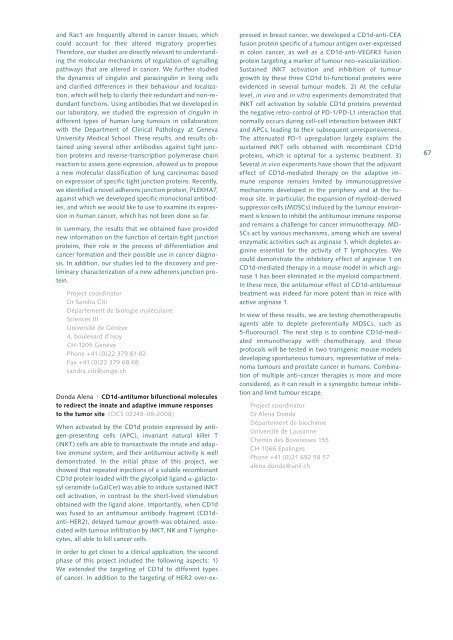Cancer Research in Switzerland - Krebsliga Schweiz
Cancer Research in Switzerland - Krebsliga Schweiz
Cancer Research in Switzerland - Krebsliga Schweiz
You also want an ePaper? Increase the reach of your titles
YUMPU automatically turns print PDFs into web optimized ePapers that Google loves.
and Rac1 are frequently altered <strong>in</strong> cancer tissues, which<br />
could account for their altered migratory properties.<br />
Therefore, our studies are directly relevant to understand<strong>in</strong>g<br />
the molecular mechanisms of regulation of signall<strong>in</strong>g<br />
pathways that are altered <strong>in</strong> cancer. We further studied<br />
the dynamics of c<strong>in</strong>gul<strong>in</strong> and parac<strong>in</strong>gul<strong>in</strong> <strong>in</strong> liv<strong>in</strong>g cells<br />
and clarified differences <strong>in</strong> their behaviour and localization,<br />
which will help to clarify their redundant and nonredundant<br />
functions. Us<strong>in</strong>g antibodies that we developed <strong>in</strong><br />
our laboratory, we studied the expression of c<strong>in</strong>gul<strong>in</strong> <strong>in</strong><br />
different types of human lung tumours <strong>in</strong> collaboration<br />
with the Department of Cl<strong>in</strong>ical Pathology at Geneva<br />
University Medical School. These results, and results obta<strong>in</strong>ed<br />
us<strong>in</strong>g several other antibodies aga<strong>in</strong>st tight junction<br />
prote<strong>in</strong>s and reversetranscription polymerase cha<strong>in</strong><br />
reaction to assess gene expression, allowed us to propose<br />
a new molecular classification of lung carc<strong>in</strong>omas based<br />
on expression of specific tight junction prote<strong>in</strong>s. Recently,<br />
we identified a novel adherens junction prote<strong>in</strong>, PLEKHA7,<br />
aga<strong>in</strong>st which we developed specific monoclonal antibodies,<br />
and which we would like to use to exam<strong>in</strong>e its expression<br />
<strong>in</strong> human cancer, which has not been done so far.<br />
In summary, the results that we obta<strong>in</strong>ed have provided<br />
new <strong>in</strong>formation on the function of certa<strong>in</strong> tight junction<br />
prote<strong>in</strong>s, their role <strong>in</strong> the process of differentiation and<br />
cancer formation and their possible use <strong>in</strong> cancer diagnosis.<br />
In addition, our studies led to the discovery and prelim<strong>in</strong>ary<br />
characterization of a new adherens junction prote<strong>in</strong>.<br />
Project coord<strong>in</strong>ator<br />
Dr Sandra Citi<br />
Département de biologie moléculaire<br />
Sciences III<br />
Université de Genève<br />
4, boulevard d’Ivoy<br />
CH1205 Genève<br />
Phone +41 (0)22 379 61 82<br />
Fax +41 (0)22 379 68 68<br />
sandra.citi@unige.ch<br />
Donda Alena | CD1d-antitumor bifunctional molecules<br />
to redirect the <strong>in</strong>nate and adaptive immune responses<br />
to the tumor site (OCS 02248082008)<br />
When activated by the CD1d prote<strong>in</strong> expressed by antigenpresent<strong>in</strong>g<br />
cells (APC), <strong>in</strong>variant natural killer T<br />
(iNKT) cells are able to transactivate the <strong>in</strong>nate and adaptive<br />
immune system, and their antitumour activity is well<br />
demonstrated. In the <strong>in</strong>itial phase of this project, we<br />
showed that repeated <strong>in</strong>jections of a soluble recomb<strong>in</strong>ant<br />
CD1d prote<strong>in</strong> loaded with the glycolipid ligand agalactosyl<br />
ceramide (aGalCer) was able to <strong>in</strong>duce susta<strong>in</strong>ed iNKT<br />
cell activation, <strong>in</strong> contrast to the shortlived stimulation<br />
obta<strong>in</strong>ed with the ligand alone. Importantly, when CD1d<br />
was fused to an antitumour antibody fragment (CD1dantiHER2),<br />
delayed tumour growth was obta<strong>in</strong>ed, associated<br />
with tumour <strong>in</strong>filtration by iNKT, NK and T lymphocytes,<br />
all able to kill cancer cells.<br />
In order to get closer to a cl<strong>in</strong>ical application, the second<br />
phase of this project <strong>in</strong>cluded the follow<strong>in</strong>g aspects: 1)<br />
We extended the target<strong>in</strong>g of CD1d to different types<br />
of cancer. In addition to the target<strong>in</strong>g of HER2 overex<br />
pressed <strong>in</strong> breast cancer, we developed a CD1dantiCEA<br />
fusion prote<strong>in</strong> specific of a tumour antigen overexpressed<br />
<strong>in</strong> colon cancer, as well as a CD1dantiVEGFR3 fusion<br />
prote<strong>in</strong> target<strong>in</strong>g a marker of tumour neovascularization.<br />
Susta<strong>in</strong>ed iNKT activation and <strong>in</strong>hibition of tumour<br />
growth by these three CD1d bifunctional prote<strong>in</strong>s were<br />
evidenced <strong>in</strong> several tumour models. 2) At the cellular<br />
level, <strong>in</strong> vivo and <strong>in</strong> vitro experiments demonstrated that<br />
iNKT cell activation by soluble CD1d prote<strong>in</strong>s prevented<br />
the negative retrocontrol of PD1/PDL1 <strong>in</strong>teraction that<br />
normally occurs dur<strong>in</strong>g cellcell <strong>in</strong>teraction between iNKT<br />
and APCs, lead<strong>in</strong>g to their subsequent unresponsiveness.<br />
The attenuated PD1 upregulation largely expla<strong>in</strong>s the<br />
susta<strong>in</strong>ed iNKT cells obta<strong>in</strong>ed with recomb<strong>in</strong>ant CD1d<br />
prote<strong>in</strong>s, which is optimal for a systemic treatment. 3)<br />
Several <strong>in</strong> vivo experiments have shown that the adjuvant<br />
effect of CD1dmediated therapy on the adaptive immune<br />
response rema<strong>in</strong>s limited by immunosuppressive<br />
mechanisms developed <strong>in</strong> the periphery and at the tumour<br />
site. In particular, the expansion of myeloidderived<br />
suppressor cells (MDSCs) <strong>in</strong>duced by the tumour environment<br />
is known to <strong>in</strong>hibit the antitumour immune response<br />
and rema<strong>in</strong>s a challenge for cancer immunotherapy. MD<br />
SCs act by various mechanisms, among which are several<br />
enzymatic activities such as arg<strong>in</strong>ase 1, which depletes arg<strong>in</strong><strong>in</strong>e<br />
essential for the activity of T lymphocytes. We<br />
could demonstrate the <strong>in</strong>hibitory effect of arg<strong>in</strong>ase 1 on<br />
CD1dmediated therapy <strong>in</strong> a mouse model <strong>in</strong> which arg<strong>in</strong>ase<br />
1 has been elim<strong>in</strong>ated <strong>in</strong> the myeloid compartment.<br />
In these mice, the antitumour effect of CD1dantitumour<br />
treatment was <strong>in</strong>deed far more potent than <strong>in</strong> mice with<br />
active arg<strong>in</strong>ase 1.<br />
In view of these results, we are test<strong>in</strong>g chemotherapeutic<br />
agents able to deplete preferentially MDSCs, such as<br />
5fluorouracil. The next step is to comb<strong>in</strong>e CD1dmediated<br />
immunotherapy with chemotherapy, and these<br />
protocols will be tested <strong>in</strong> two transgenic mouse models<br />
develop<strong>in</strong>g spontaneous tumours, representative of melanoma<br />
tumours and prostate cancer <strong>in</strong> humans. Comb<strong>in</strong>ation<br />
of multiple anticancer therapies is more and more<br />
considered, as it can result <strong>in</strong> a synergistic tumour <strong>in</strong>hibition<br />
and limit tumour escape.<br />
Project coord<strong>in</strong>ator<br />
Dr Alena Donda<br />
Département de biochimie<br />
Université de Lausanne<br />
Chem<strong>in</strong> des Boveresses 155<br />
CH1066 Epal<strong>in</strong>ges<br />
Phone +41 (0)21 692 58 57<br />
alena.donda@unil.ch<br />
67

















